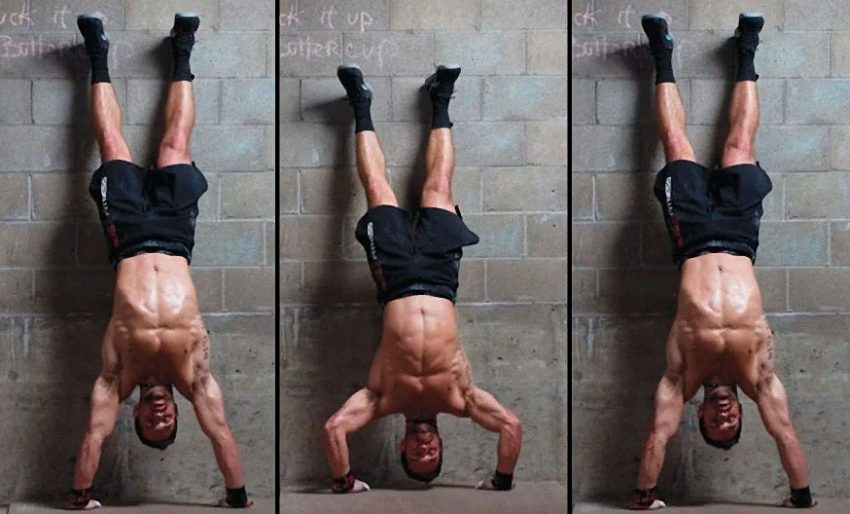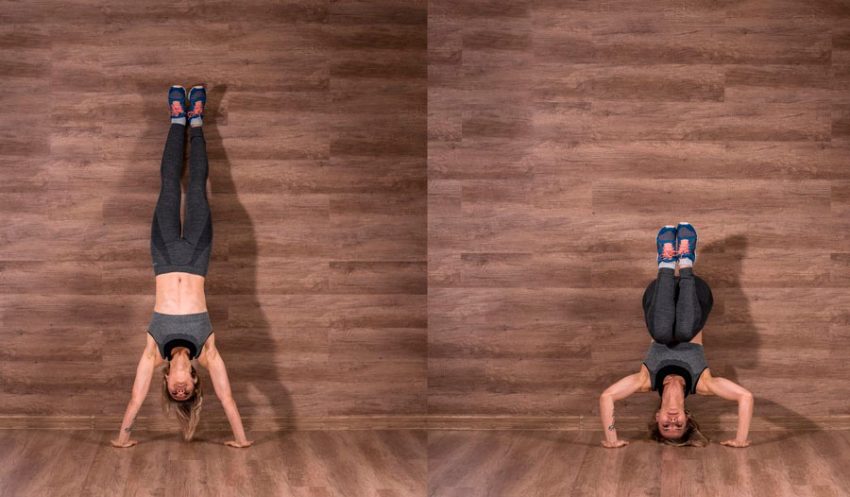Vertical push-ups or push-ups in a rack is an exercise from artistic gymnastics. It is common in CrossFit too. Many people would like to learn how to do push-ups in a rack, because it is impressive. In fact, movement requires remarkable physical strength, balance, and body control. But gradually almost everyone who does not have serious injuries of the shoulders, chest, and severe curvature of the spine can learn to gradually push up in a standing position.
Execution technique

Initial position
- Starting position – standing against the wall, at a distance of about one and a half meters from its surface;
- Bending forward is performed, palms are placed 10-12 cm wider than the feet than the heads of the shoulders;
- The body weight is transferred to the palms, fingers are spread out;
- Legs are thrown onto the wall by inertia;
- It is necessary to flip the body;
- After that, rest your feet or heels against the wall, tighten your stomach and buttocks so that the body position is sufficiently fixed, and the athlete can do push-ups in a stable position.
Traffic
- Bend the elbows to the available depth of amplitude;
- Come down;
- Due to the strength of the deltoid and trapezoidal, squeeze out to the starting position;
- The legs move freely along the wall, their task is to maintain the position of the body;
- The number of times required according to the plan is performed, preferably in the amplitude that will be of high quality and affordable.
Attention
- Do not stand on your head to rest, this can lead to injury to the cervical vertebrae;
- Spend a few minutes learning how to make the starting stance correctly. Let someone back you up, and you will not change your body position too abruptly;
- Do not put your palms far forward, but do not place them on the line of the head. The push-up trajectory should be similar to the bench press;
- Try not to swing so that the amplitude does not change;
- Do not do the exercise too far from the wall, a large deflection in the lumbar spine is not only harmful to the back, but also does not contribute to stability;
- Pay attention to the position of the palm and fingers, as well as the forearms. They should not experience discomfort due to overload.
Recommendations

- Provide yourself with the widest possible support area. Try to put your fingers as wide as possible, so that you stand firmly in the support;
- Work on the width of your palms. Fix the position of the body so that it is convenient to do push-ups, bringing the elbows slightly to the side or forward;
- Bend your arms at the same speed, do not fall through to one side;
- Place a special support or a regular mat under your head;
- Don’t be ridiculous, this can lead to injury;
- Place your palms at the same distance from the shoulder joint, if on one side the distance is a little further, you can “fall” on this side or just simply fall corny;
- Tighten your body so that the stabilizer muscles are involved, and there is no collapse of the body in one direction or another;
- Do not use headrests that are too high to avoid artificially reducing the range of motion.
Execution options

- Kipping push-ups . It is used in CrossFit when the goal of the athlete is to finish the exercise as soon as possible. This discipline usually refers to kipping as a distinct style. That is, there should be an explanation that it is allowed. At the stage of lowering, there is almost no distinguishable, but the rise can be realized by pushing with the legs. Part of the body weight “leaves” the hands due to this inertial movement. The kick is done with the heels up, and resembles pushing off in a thruster or jumping onto a box.
- Free standing hand push-ups . It is available to athletes who can stand and walk on their hands. The secret of this variation of the exercise lies precisely in the skill of the handstand. To reach this level, you must first learn to push up from the “corner” or “dog head down”, lowering your head to the floor, and then – push-ups, moving your legs in the “corner” on a support, for example, on a cube. The next level of difficulty is the variation with legs in the manger, and the final, the most difficult, is in the full stance. This movement is distinguished by the “assembly” of the abdomen, you need to learn how to tighten the anterior abdominal wall so that the skill of the stand appears. It makes sense to teach full standing push-ups with a spotter.
